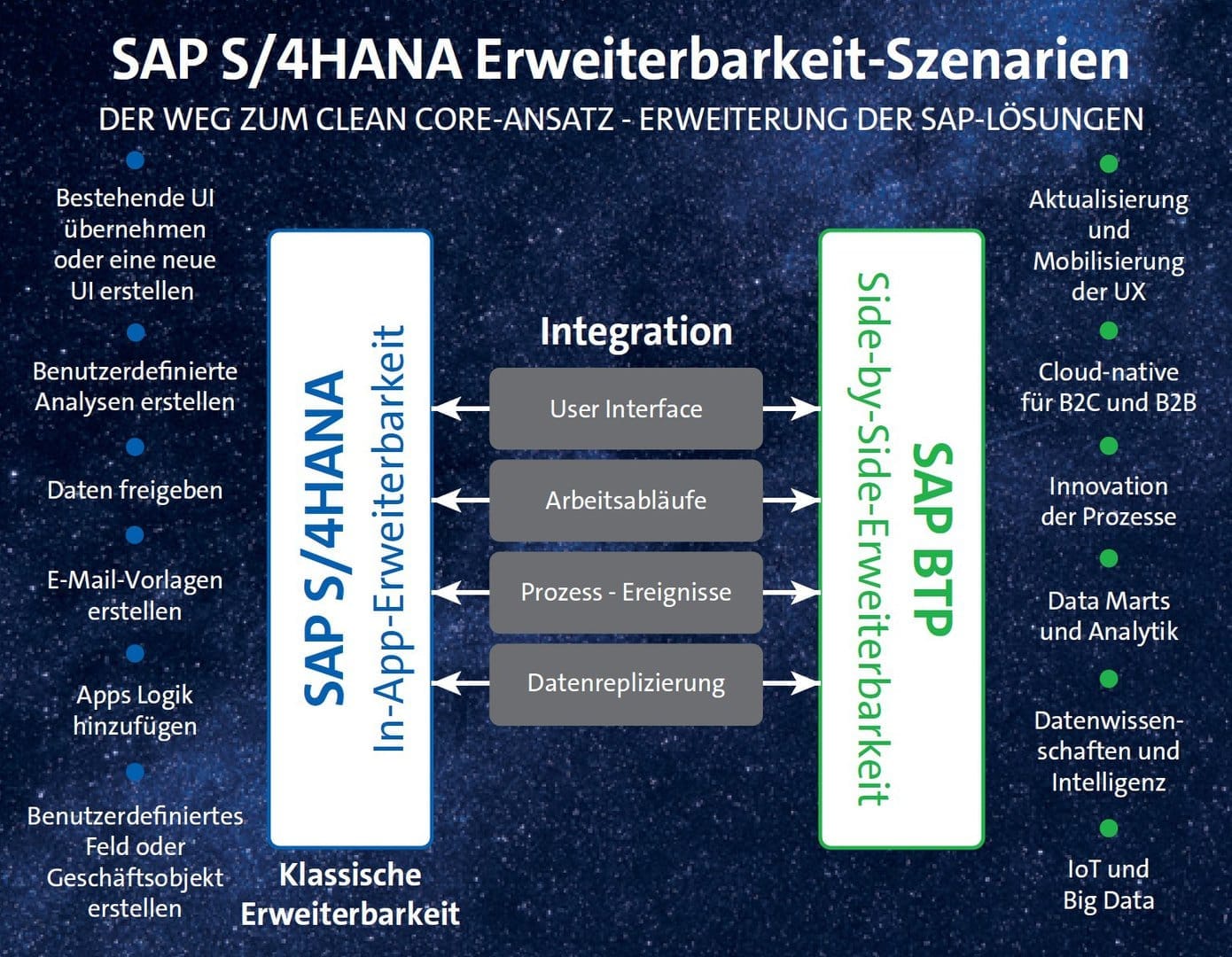Analysis of Clean Core Approaches for SAP S/4 Hana Migration


As the support for ECC 6.0 comes to an end, many companies adopting S/4 are facing the challenge of avoiding complex customizations. Such modifications can result in more challenging and costly future upgrades. LeverX's clean-core strategy is designed to maximize the flexibility and performance of S/4 by adhering closely to SAP's standard functionalities. This approach minimizes the need for customizations that could impede updates or prevent the introduction of new innovations. By maintaining a clean S/4 core, companies can enjoy seamless updates, accelerated implementations, and uninterrupted access to the latest tools and features from SAP.
What modifications can be made to the system to align it with specific customer requirements? There are three main approaches to clean core extension: in-app key user, on-stack developer, and side-by-side extensibility on SAP BTP. The first two approaches are integrated directly within S/4, while side-by-side extensibility utilizes the BTP, enabling flexible customization via a separate platform.
In-app key user
In-app extensibility is an optimal solution for straightforward customizations directly in S/4 Hana, as well as for instances where business users require rapid adjustments without significant technical intervention. This approach allows users to make low-code/no-code changes, such as creating custom fields, form templates, or basic analytics, directly within the SAP S/4 Hana environment.
The approach allows users to customize existing user interfaces, create custom analyses, access data, and manage templates and business objects. Non-developers are empowered to make customizations directly in S/4 Hana. This reduces the necessity for external integrations and enables seamless system upgrades. In-app extensibility is well-suited to companies that require simple or cosmetic customizations without compromising SAP's built-in functionality.

On-stack developer
On-stack developer extensibility is the optimal solution for advanced customizations directly in S/4, as it allows for frequent data interactions. It is crucial for organizations that require extensive customizations, such as adding application logic or developing new business objects that require seamless integration with S/4 data. By leveraging the Abap programming language and environment, this approach enables complex customizations to be made within the S/4 environment, ensuring that all changes are kept within the system.
It supports the addition of complex application logic and enables the creation of user-defined business objects. This approach guarantees optimal data consistency by operating directly in S/4. External dependencies, such as those created through API calls, are avoided. This enhances the overall system integrity. On-stack developer extensibility is ideal for custom applications that require real-time data interactions within S/4, ensuring a consistent and responsive system as part of the classic Abap stack.
Side-by-side
Side-by-side extensibility on SAP BTP is ideal for independent applications that run outside of S/4 and leverage advanced capabilities such as AI, machine learning, IoT, data science, process automation and other powerful low-code/no-code environments to build business applications. This approach allows organizations to innovate without compromising the S/4 core, while providing a stable foundation for complex cross-platform integrations. Side-by-side extensibility enables a range of advanced enhancements, including updates to user experiences, mobilization of solutions, creation of cloud-native applications for B2B and B2C, and addition of data science capabilities.
One of the key benefits of the approach is that the S/4 core is kept clean by running independently, reducing upgrade challenges and improving cloud readiness. Projects that require extensive customization or cross-system integrations can benefit from the processing power and flexibility of SAP BTP. It is also beneficial when external users (who may not be part of S/4) require access to applications.

Selecting the right concept
The selection of an extension concept is contingent upon the specific needs, intricacy, and long-term objectives of a company. Each strategy within the clean core framework—whether in-app, on-stack, or side-by-side—serves different purposes and fulfills different requirements for flexibility, scalability, and system integrity. In some instances, a hybrid approach may prove to be the optimal solution. By assessing each individual case, companies can determine the optimal combination of methods to achieve their development goals.
All of these approaches are based on the same fundamental principles, which are designed to maintain a clean core. These include avoiding unnecessary customization, aligning with SAP standards, and regularly reviewing technical debt to optimize systems. The objective is to implement a zero-change policy, utilize SAP BTP for further innovation, and rely on standard APIs and events for automation. Additionally, all enhancements must be cloud-ready and adaptable to future developments. When examining specific enhancement strategies based on customer types, one of two concepts are typically employed: the brownfield approach or the greenfield approach.
Brownfield
The greenfield approach is used by companies that are implementing S/4 Hana for the first time. It offers a fresh start without outdated customizations and enables an optimized, scalable setup. The new implementation facilitates a gradual introduction, simplifies future updates, and ensures an optimized, scalable setup. With minimal customization, this strategy ensures that the SAP environment adheres to best practices and responds flexibly to changing requirements.
Greenfield
The greenfield approach is used by companies that are implementing S/4 Hana for the first time. It offers a fresh start without outdated customizations and enables an optimized, scalable setup. The new implementation facilitates the gradual introduction, simplifies future updates and ensures an optimized, scalable setup. With minimal customization, this strategy ensures that the SAP environment adheres to best practices and responds flexibly to changing requirements.
While a migration to S/4 may not be a priority in the short term, it is crucial to reduce existing technical debt. By adopting new technologies at an early stage and pursuing a clean-core approach, the costs associated with future development can be significantly reduced. This proactive strategy has the dual benefit of minimizing business disruption and ensuring that the system remains agile and future-proof.
Selecting the clean core approach is essential for establishing a sustainable S/4 environment. Partners like LeverX provide strategic expertise to facilitate a seamless transition. In the next article, we will examine how a well-defined strategy and the application of best practices can enable an efficient migration.






